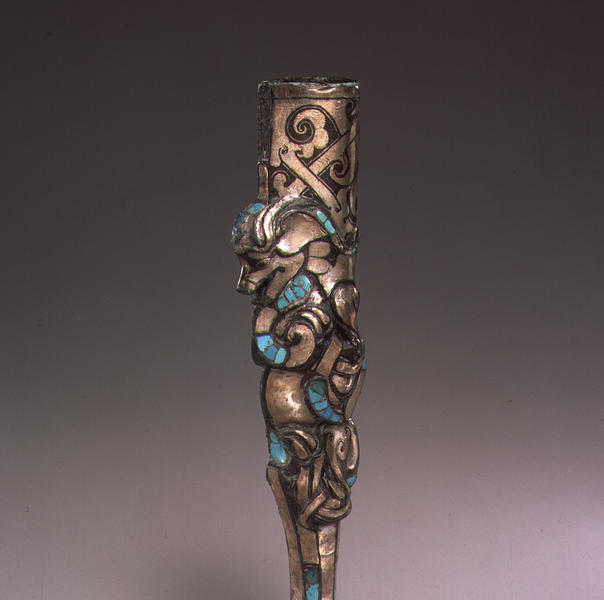Ferrule (Zun)
- China
- China, Late Eastern Zhou period
- 3rd century B.C.
- Bronze with silver sheet and turquoise inlays
- H-18.3 D-4 W-2.6
Catalogue Entry
During the latter half of the Eastern Zhou period, rivalry and warfare among contending states escalated to unprecedented heights. Articles of war, whether functional or ceremonial, became important status and power symbols for the military and ruling elite. Lavishly embellished fittings like the present examples form a large category of luxury items that adorned functional articles of war, sometimes presented to deserving soldiers for feats of bravery and military achievements.
These three fittings, with their diagnostic blunted almond-shaped sockets, served as butt-ends to the wooden or bamboo shafts of bronze ge (a type of halberd) or spears, the most common weapons used throughout Bronze Age China.1 The ge blade is a thrusting weapon mounted at right angles to the shaft. The lengths of the shafts varied, probably determined by the circumstances of the weapon's use. The battle scenes on a fifth-century B.C. bronze vessel from Ji Xian Shanbiaozhen, Henan province, depict soldiers wielding ge blades on shafts that range from half a man's height to one and half times his height (i.e., 1-2.5 meters).2 This is supported by the discovery of numerous ge blades with preserved shafts and fittings from Eastern Zhou burials in the Jiangling and Jingmen areas of Hubei province. The shafts recovered ranged from 0.5-2.18 meters in length, with the majority being 1.1 to 1.5 or 1.8 meters long.3 Spear shafts, however, typically ranged from 2-2.5 meters long, with extra-long versions reaching 3.5 to 4 meters.4 The extra weight of a bronze butt at the opposite end of the shaft would have provided better balance for the thrusting motion of the ge and spear.
The elaborate inlays on these fittings are meant to reflect the prestige of their owners. On one fitting, number 96, gold and silver foil and thin wire accent the scaled body and feathers of a bird whose head, marked by a pronounced beak, appears about midway. Silver in thick sheets and thin wire-like strips and turquoise bits describe a hoofed and clawed animal on the second fitting, number 97. Its head projects about one-third from the top, showing a blunt snout and large floppy ears characteristic of boar-like animals. The predominantly cool colors of silver and turquoise are unusual for inlaid bronzes of the period.
The third ferrule, number 98, differs from the previous two examples in several ways. It is significantly longer, has a flat bottom, and a fluted collar near the top interrupts its otherwise unbroken profile. Its decoration is purely abstract, consisting of gold and silver foil inlaid into precast depressions in geometric configurations of broadly sweeping scrolls accented by spiraling elements. The design displays an elegant restraint and a deliberate, lilting rhythm that is almost Mozartian.
Chinese archaeologists sometimes distinguish between these ferrule types--ones with broken profiles and hoof-shaped ends (96, 97) and ones with straight profiles and flat bottoms (98)--by referring to them as dun and zun respectively. Evidence indicates that hoof-shaped and flat-bottomed ferrules can both be associated with ge blades, but flat-bottomed ferrules can also occur with spearheads. Although the specific functions of these two types of fittings cannot be easily determined, the greater length of 98 suggests that it might have capped the end of a long-shafted blade, perhaps a spear.
JFS
1. Loehr 1956, chaps. 2-3.
2. Guo 1959, p. 21, fig. 11.
3. Hubei sheng 1991, p. 208; Hubei sheng 1995, pp. 229-3; pl. 75.1.
4. Hubei sheng 1991, p. 205; Guangzhoushi et al. 1991, pl. 105.4-.5.
Ferrule (zun)
